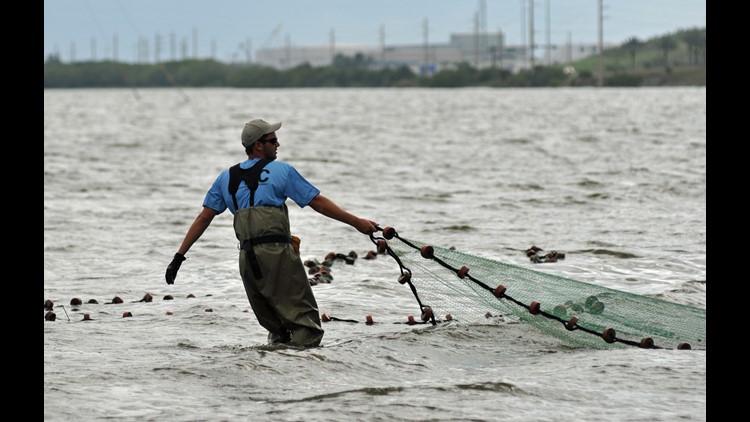![FWC research boat for fish kill [image : 82511528]](http://www.gannett-cdn.com/-mm-/a095cf3b9ae948b007f25d867f04c8800baadfd6/c=332-0-2752-2068/local/-/media/2016/04/01/Brevard/Brevard/635951043178319973-MAIN-B-FWC-research-boat-8.jpg-20160330-1.jpg)
MELBOURNE, Fla. — The ides of March ushered in the worst known fish kill in Indian River Lagoon history, a watershed moment in a war to save a $3.7 billion annual economic engine.
Scientists say low levels of dissolved oxygen in the lagoon’s waters led to thousands of fish suffocating. More than 30 species in all died in the kill-off.
The same scientists believe the recent “brown tide” of algae blooming in the lagoon is responsible for the low oxygen levels.
The massive death spiral outraged the collective conscience of coastal residents, leaving many scratching their heads, pinching their noses and wondering what’s next: Dolphins? Manatees? Pelicans? A repeat of four years ago when all three died en masse?
Researchers say it likely will be years before the full impact of the fish kill is known.
![Fla. biologist to investigate major fish kill [oembed : 82592146] [oembed : 82592146] [oembed : 82592146] [oembed : 82592146]](/Portals/_default/Skins/PrestoLegacy/CommonCss/images/smartembed.png)
Biologists expect ecological ripple effects, especially for dolphins, redfish and other top predators. As the concentration of brown tide algae wanes, fish will rebound, they say. But warmer weather could reap a repeat, although with many fewer fish around to die. Rotted fish are fermenting fodder for new algae blooms, and ultimately will add to the pasty black muck that also helps fuel blooms. Bacteria decomposing the fish consume oxygen in the water, further increasing risk of another kill.
Nobody knows how many fished died. But the images that sent shock waves throughout the region show what seems an entire generation of fish wiped out overnight in the northern lagoon. Fisheries ecologists worry as much about the next generation as they do for those left behind. And the early onset of this year’s brown tide – which typically blooms in the warmer summer months – has many dreading the rest of the year will be all bloom and doom.
“My biggest concern is that it might have also affected all of the juvenile fish,” said Jon Shenker, a fish biologist at Florida Institute of Technology in Melbourne. “We may still see a bunch of big fish around, but in a few years, there aren’t going to be any new fish to replace all of the old fish.”
Are dolphins doomed?
Dolphins already taxed by water pollution could starve, unless they give up their territorial tendencies and search for food afar of their usual lagoon hang outs.
“There are two choices here,” Greg Bossart, chief veterinary officer at the Georgia Aquarium, said of the lagoon’s apex predator. “One is to stay there and have no food to eat, or to leave ... Either way, it puts the dolphins in a hard position. The Indian River dolphins don’t need any more challenges in their life history in the lagoon.”
Bossart has been led a federally funded study of the lagoon dolphins’ health since 2003. He’s found, among other things, elevated incidence of emerging diseases, antibiotic resistant bacterial infections, and the highest mercury levels ever measured in dolphins.
![FWC research boat for fish kill [image : 82511524]](http://www.gannett-cdn.com/-mm-/320c686ca02be6a6f8673db765aeae41cb7b700b/c=0-0-3140-2684/local/-/media/2016/04/01/Brevard/Brevard/635951043161939763-MAIN-A-FWC-fish-kill-research-boat-6.jpg-20160330.jpg)
“It’s just a myriad of health issues that are worrisome, because these animals tend to be very good sentinels of the health of the ecosystem,” Bossart said. “They’re trying to tell us something, and we’re not very good at listening.”
One of the messages dolphins have been sending loud and clear is that they’re already struggling to find fish to eat, because of long-term declines in the seagrass habitat that fish need to survive. Biologists often find malnourished dolphins in the lagoon. And although dolphins and fish can venture to new areas, the competition for prey and habitat is becoming increasingly fierce.
“They only eat fish, period. They don’t eat anything else,” Bossart said.
More than just a fish kill
Grant Gilmore, a fish ecologist in Vero Beach, has been studying the lagoon’s fish for 45 years. This is the worst fish kill he’s seen in the estuary, and it left him with more questions than answers. He wants DNA studies of the algae to find out where it originated and what makes it bloom.
The fish kill’s origins in one of the least developed areas of the lagoon — the no-motor zone of the Merritt Island National Wildlife Refuge — especially surprised Gilmore.
![Indian River Lagoon fish kill worst in memory [oembed : 82592152] [oembed : 82592152] [oembed : 82592152] [oembed : 82592152]](/Portals/_default/Skins/PrestoLegacy/CommonCss/images/smartembed.png)
“I wouldn’t have said that area, because no one lives up there,” Gilmore said. “Why did it happen where it happened? Will it happen elsewhere? What we really need to do is have detailed studies of what’s going on.”
Gilmore calls for a more extensive network of water quality sensors similar to what’s on Florida’s Gulf Coast, with particular attention paid to the strains of algae that have bloomed in recent years.
“Create blooms in the lab, see what’s going on here,” Gilmore added. “Why do we have them now? We didn’t have them before. Are they exotics? Did they come through Port Canaveral?”
![FWC research boat for fish kill [image : 82511522]](http://www.gannett-cdn.com/-mm-/d0cc6300cadb54d1fcdea1b11fc39efb6bed0eeb/c=548-0-3740-2728/local/-/media/2016/04/01/Brevard/Brevard/635951043142439513--FWC-fish-kill-research-boat-7.jpg-20160330.jpg)
But algae not only depletes oxygen in the water. It also clouds the water, blocking needed sunlight from reaching seagrass on the lagoon’s bottom. The seagrass plays a vital role in the ecosystem. It is an important food source for manatees and other creatures and also acts as a nursery for young fish where they can hide from predators.
In 2011, a severe “superbloom” of green algae covered much of the northern lagoon. Biologists suspect extreme climate — including consecutive cold winters and extended drought — coupled with a decades-long buildup of nitrogen and phosphorus from fertilizers, septic tanks and other sources shifted the lagoon to a phytoplankton-dominant system, rather than one dominated by seagrass.
Scientists don’t know what caused about 140 manatees, 80 dolphins and up to 300 brown pelicans to die after the 2011 superbloom and brown tides that followed, which in all killed 47,000 acres – or 60 percent – of lagoon seagrass. Not much of that grass grew back, and biologists can’t even measure the grass until the algae bloom dissipates.
No one knows how brown tide got here or whether it was always here, just at low levels.
Brown tide algae can dominate in salty water, as it did in the salty Laguna Madre and Baffin Bay along Texas’ Gulf Coast in the early 1990s, killing off seagrass for years. The bloom lasted almost eight years, making it the longest continuous harmful algae bloom ever recorded.
After extended drought, the northern lagoon and Mosquito Lagoon can reach salt levels higher than the ocean.
A similar brown tide species emerged in coastal waters off New England and New York in the mid-1980s, devastating scallops, clams and seagrass in Long Island’s southern bays.
The brown tide algae first popped up in bloom levels in the summer of 2012, in Mosquito Lagoon, migrating west into the northern Indian River Lagoon. It was the first bloom of the species documented in Florida. It never spread south of Titusville. But as much as 50 square miles of lagoon seagrass had already died a year earlier, after another type of algae bloomed from Titusville to Eau Gallie and a separate, concurrent bloom stretched from Eau Gallie to south of Vero Beach.
A lesser brown tide emerged in the lagoon in 2013 and the algae failed to bloom in 2014, but by December 2015 it was raging once again.
“We’ve been seeing cells like this since 1997, but never anywhere near these densities,” said Ed Phlips, professor of algal physiology and ecology at the University of Florida.
Although not toxic to humans, in some ways brown tide can be worse than toxic algae blooms, at least economically. It put countless scallop fishermen and clammers out of work in Long Island in the 1980s and has bloomed there almost every year since.
Brown tide also produces a mucus that clogs up and kills shellfish. And the algae causes declines in microscopic floating animals, such as amoeba, that provide food for many marine organisms.
Lake Okeechobee not at fault
Fish know no political boundaries. But the large water releases from Lake Okeechobee that foul the southern lagoon have no bearing on water quality where the northern lagoon fish kill occurred.
“That’s out of the question,” Gilmore explained. “It’s too far away. There’s no real hydrological connection.”
![Cocoa Beach [image : 82131272]](http://www.gannett-cdn.com/-mm-/04e9cfc8cb733e04ab45a03318e6d636f61668b4/c=0-0-2848-2434/local/-/media/2016/03/22/Brevard/Brevard/635942592367794404-Fish-Kill-4.jpg)
But fish from here swim to the southern lagoon and vice versa, so fisheries elsewhere could feel a pinch from Brevard’s die off. Black drum tagged near Kennedy Space Center, for example, have “pinged” as far north as New Jersey.
“The snook are the most migratory,” Gilmore said. “Spotted seatrout are the least migratory.”
Pinfish and other fish low on the food chain will return fairly quickly.
“There are some that come in right away. Pinfish are always hunting for territories. There are some species that will repopulate quickly,” Gilmore said.
Have we seen the worst of it?
If the water stays clear long enough for the seagrass to recover, as it enters its peak growing season, the seagrass could take up the nutrients the algae needs to bloom. Drift algae also could sponge up some of those nutrients.
But brown tide’s early attack has many lagoon advocates worried.
“We’re entering the bloom season,” Phlips warns.
Brevard County Commission balked at a resolution Tuesday to ask the governor to declare an emergency, but those who have spent lifetimes on the lagoon already see an entire estuary on life support, with its vital signs dimming.
“I’ve watched the rise and the fall of that river something fierce,” said Kenneth Clark, 60, of Frontenac, who’s lived within a block of the lagoon his entire life. He was an on-again-off-again clammer and watched clams vanish in the 1990s, when many commercial fishermen converged on the lagoon after shellfish in northern estuaries collapsed.
Clark hopes clams can be re-established to help filter the lagoon. He also pines for a return to the days when he could hook dozens of redfish in one trip.
“It’s few and far between that you get any strikes anymore,” Clark said.
He’s careful to maintain his septic tank and wonders why anyone would have St. Augustine grass and use weed killer along the lagoon watershed.
“It’s the fertilization, it’s the clippings,” Clark said. “They blow it in the road. Nobody cares. Nobody gives out tickets. Nobody gives out fines.”
A 600-foot-long research net dragged through the northern lagoon Wednesday revealed all is not lost. Staff with the Fish and Wildlife Research Institute conduct random net sampling throughout the lagoon. They’ll need years of data collection to determine the impacts of the lagoon’s largest-known fish kill.
This day, a haul of their sein net near KARS Park on Merritt Island yielded hope: healthy-sized redfish, sheepshead, pinfish, horeshoe crabs and mullet.
“It was very promising,” said Richard Paperno, research administrator with the FWRI.
He says rain and winds should further break up the already waning bloom.
“I’m hoping that will bring an end to the problems we’re seeing,” Paperno said. “I think it caught everyone by surprise that it happened as soon as it did.”
Follow Jim Waymer on Twitter: @JWayEnviro



![Photos: Fish Kill Cocoa Beach [gallery : 82131418]](http://www.gannett-cdn.com/-mm-/607f4ca9bb271ba21d1c54533133fc26646fae45/c=478-0-3810-2848/local/-/media/2016/03/22/Brevard/Brevard/635942595297588165-Fish-Kill-1.JPG)
